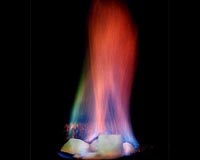 |
Oak Ridge TN (SPX) May 19, 2011 Billions of dollars lost each year as waste heat from industrial processes can be converted into electricity with a technology being developed at the Department of Energy's Oak Ridge National Laboratory. The high-efficiency thermal waste heat energy converter actively cools electronic devices, photovoltaic cells, computers and large waste heat-producing systems while generating electricity, according to Scott Hunter, who leads the development team. The potential for energy savings is enormous. "In the United States, more than 50 percent of the energy generated annually from all sources is lost as waste heat," Hunter said, "so this actually presents us with a great opportunity to save industry money through increased process efficiencies and reduced fuel costs while reducing greenhouse gas emissions." Initially, Hunter envisions the technology being used for cooling high-performance computer chips, thereby helping to solve an enormous problem facing manufacturers of petaflop-scale computers. These mega machines generate massive amounts of heat that must be removed, and the more efficient the process the better. Turning some of that heat into electricity is an added bonus. Hunter's technology uses cantilever structures that are about 1 millimeter square in size. About 1,000 of these energy converters can be attached to a 1-inch square surface such as a computer chip, concentrated photovoltaic cell or other devices that generate heat. Although the amount of electricity each device can generate is small - 1 to 10 milliwatts per device - many arrays of these devices can be used to generate sizable amounts of electricity that can power remote sensor systems or assist in the active cooling of the heat generating device, reducing cooling demands. The underlying concept, pyroelectricity, is based on the use of pyroelectric materials, some of which have been known for centuries. First attempts to use this technology to generate electricity began several decades ago, but these studies have been plagued by low thermal to electricity conversion efficiencies - from about 1 to 5 percent. This is also the case for techniques using thermoelectric, piezoelectric and conventional pyroelectric platforms. However, using arrays of cantilevered energy converters that feature fast response and cycle times, Hunter's team expects to achieve efficiencies of 10 to 30 percent - depending on the temperature of the waste heat generator - in an inexpensive platform that can be fabricated using standard semiconductor manufacturing technology. "The fast rate of exchange in the temperature across the pyroelectric material is the key to the energy conversion efficiency and high electrical power generation," Hunter said, adding that ORNL's energy scavenger technology is able to generate electrical energy from thermal waste streams with temperature gradients of just a few degrees up to several hundred degrees. The device is based on an energy harvesting system that features a micro-electro-mechanical, or MEMS, pyroelectric capacitor structure that when heated and cooled causes current to flow in alternate directions, which can be used to generate electricity. In this configuration, cantilevers are attached to an anchor that is affixed to a waste heat generator substrate. As this substrate becomes hot, the cantilever also heats and bends because of the bi-material effect, similar in principle to the bimetal switch used in room and oven thermostats. "The tip of the hot cantilever comes into contact with a cold surface, the heat sink, where it rapidly loses its heat, causing the cantilever to move back and make contact with the hot surface," Hunter said. "The cantilever then cools and cycles back to the cold heat sink. "The cantilever continues to oscillate between the heat source and heat sink as long as the temperature difference is maintained between the hot and cold surfaces." Other developers of this technology, which is funded by the Laboratory Directed Research and Development program, are Nickolay Lavrik, Thirumalesh Bannuru, Salwa Mostafa, Slo Rajic and Panos Datskos. UT-Battelle manages ORNL for DOE's Office of Science.
Share This Article With Planet Earth
Related Links DOE/Oak Ridge National Laboratory Powering The World in the 21st Century at Energy-Daily.com
 Newly Installed Alaska North Slope Well Will Test Hydrate Production Tech
Newly Installed Alaska North Slope Well Will Test Hydrate Production TechWashington DC (SPX) May 19, 2011 A fully instrumented well that will test innovative technologies for producing methane gas from hydrate deposits has been safely installed on the North Slope of Alaska. As a result, the "Ignik Sikumi" (Inupiaq for "fire in the ice") gas hydrate field trial well will be available for field experiments as early as winter 2011-12. The well, the result of a partnership between ConocoPhillips a ... read more |
|
| The content herein, unless otherwise known to be public domain, are Copyright 1995-2010 - SpaceDaily. AFP and UPI Wire Stories are copyright Agence France-Presse and United Press International. ESA Portal Reports are copyright European Space Agency. All NASA sourced material is public domain. Additional copyrights may apply in whole or part to other bona fide parties. Advertising does not imply endorsement,agreement or approval of any opinions, statements or information provided by SpaceDaily on any Web page published or hosted by SpaceDaily. Privacy Statement |